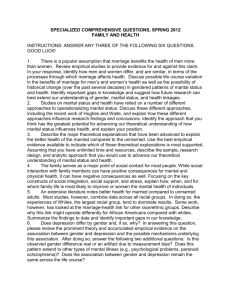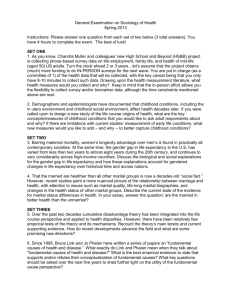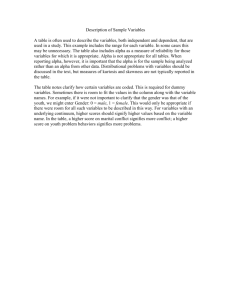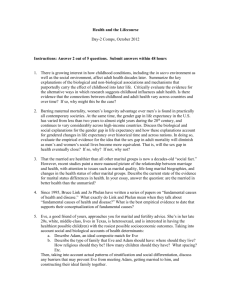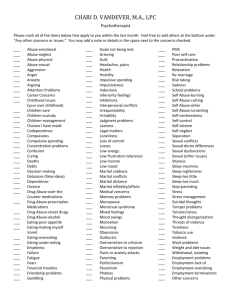Marital Status Discrimination - Work and Family Researchers Network
advertisement
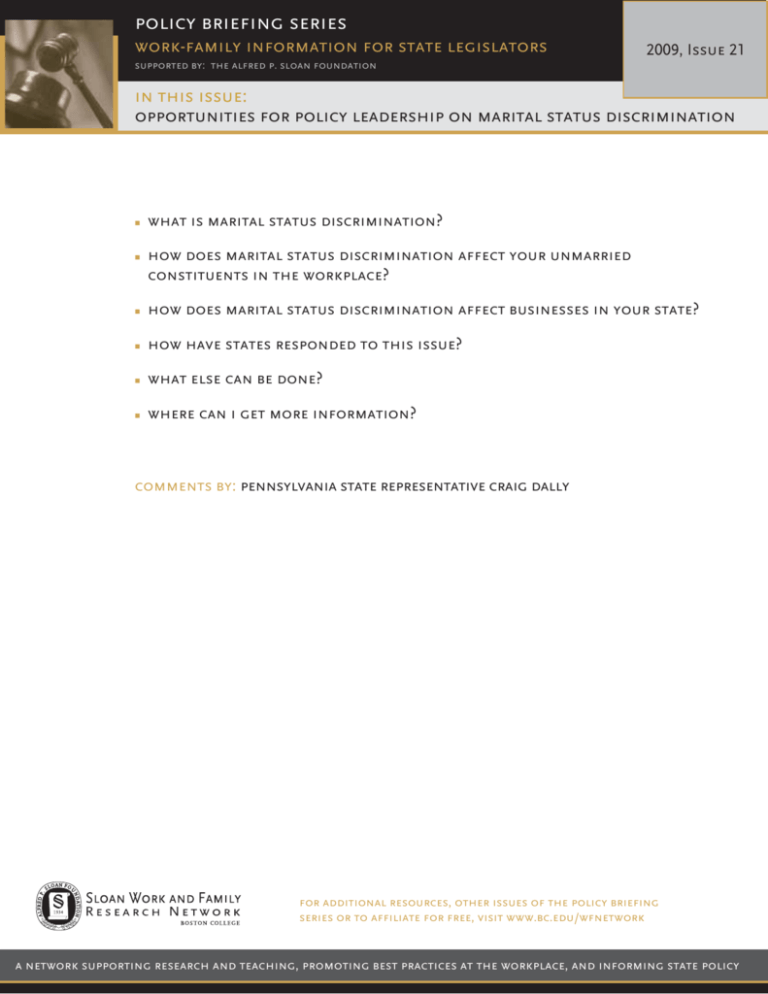
policy briefing series work-family information for state legislators 2009, Issue 21 supported by: the alfred p. sloan foundation in this issue: opportunities for policy leadership on marital status discrimination what is marital status discrimination? how does marital status discrimination affect your unmarried constituents in the workplace? how does marital status discrimination affect businesses in your state? how have states responded to this issue? what else can be done? where can i get more information? comments by: pennsylvania state representative craig dally for additional resources, other issues of the policy briefing series or to affiliate for free, visit www.bc.edu/wfnetwork a network supporting research and teaching, promoting best practices at the workplace, and informing state policy 2009, Issue 21 policy briefing series work-family information for state legislators © 2009 created by: supported by: the alfred p. sloan foundation Prepared by: Mary Curlew, MSW; Julie Weber, JD opportunities for policy leadership on marital status discrimination As workplaces become more “family-friendly,” unmarried employees may question the fairness of these policies. American households are changing. According to the U.S. Census Bureau, 95.9 million Americans 18 years of age and older were unmarried in 2008, up from 37.5 million in 1970.1 Unmarried employees make up over 40% of the full-time workforce.2 In addition, the percentage of families with children under age 18 at home has declined.3 Despite these demographic shifts, research and anecdotal evidence indicate that most work-family initiatives are directed toward the needs of married employees with children,4 resulting in a “family-friendly” backlash among unmarried workers, especially those without children at home. number of unmarried americans by sex 1950-2008 70000 60000 50000 40000 Male Female 30000 20000 10000 19 50 19 60 19 70 19 80 19 90 19 93 19 94 19 95 19 96 19 97 19 98 19 99 20 00 20 01 20 02 20 03 20 04 20 05 20 06 20 07 20 08 0 source: u.s. census bureau (2009) what is marital status discrimination? Marital status discrimination occurs when a person or persons are granted or denied certain rights based on their marital status. Marital status discrimination is not restricted to a certain gender or sexual orientation, although it may impact certain populations more than others. Several cases have challenged polices that appear to favor married employees. For example, in Russ v. City of Troy (2001), the plaintiff established a valid claim for discrimination based on the fact that he was denied a promotion because he was unmarried. More recently, in Wojan v. Alcon Laboratories (2008), Wojan, a single mother, brought suit against her employer after she was fired for poor performance. Wojan states that the company failed to modify her quota requirements during her maternity leave and that her employer made inappropriate comments about her marital status after her return. Alcon Laboratories’ motion for summary judgment was denied, and as of December 2009, the case was still pending. “common sense dictates that hiring decisions should be made on a person’s qualifications and work history, not on a person’s marital status or whether or not she or he is a single parent. no one, much less single mothers trying to make lives better for their families, should be subject to such harassment.” — pennsylvania state representative craig dally (r) on hb 280 how does marital status discrimination affect unmarried constituents in the workplace? Several findings suggest that employees may be treated differently based on their marital status: Married men are paid more and are offered promotions more often than single men, even when controlling for work performance and seniority.5 Employers are often able to subsidize health benefits for spouses and sometimes domestic partners, while offering no additional compensation for unmarried or single employees.5 Work-family policies are often written to address married employees with children. 4 For example, dependent care allowances and parental leave are directed specifically to employees with children and are often not available to low-income single mothers.6 Flexible work schedules are more often available to employees from dual-earner families with children, as well.2, 7 Unmarried workers and single workers without children are expected to travel more for work; they also feel that they have to work at times that are not expected for working parents.2 In addition, parents are more likely to get time off from work than nonparents.2 how does marital status discrimination affect businesses in your state? Emerging research on marital status and the work environment of singles shows that providing work-life programs to a wider array of employees can be beneficial to employers by: Reducing turnover, increasing job satisfaction and productivity, and attracting a more diverse applicant pool.2 Decreasing benefit costs through flexible benefits (i.e., benefits that are tailored to each employee’s need). Offering flexible benefits can save businesses money because employees are offered a defined contribution (i.e., a set expenditure to be spent on benefits) rather than a defined benefit (benefit packages are guaranteed, regardless of cost).8 Increasing employees’ perception of fairness and thus preventing discrimination lawsuits based on marital status.8 how have states responded to this issue? Prohibiting marital status discrimination in employment: Under federal law, only the Civil Service Reform Act of 1978 protects federal employees from discrimination based on marital status. The Equal Employment Opportunity Act does not. However, 21 states (AK, CA, CT, DE, FL, HI, IL, IN, MD, MI, MN, MT, ND, NE, NH, NJ, NY, OR, VA, WA, WI) and the District of Columbia offer protection against discrimination in employment based on marital status. Of these 21 states: Six states make exceptions to marital status discrimination in regard to benefit allocation (AK, CA, DE, MD, MI, MT) Two states protect teachers against marital status discrimination (CT, IN) Five states make exceptions to marital status discrimination in employment when anti-nepotism policies exist (CA, FL, MT, NE, WI) WA ME ND MT OR MN ID States that have passed laws addressing martial status discrimination. WY WI SD UT CA IL CO KS NM OH WV KY SC AL GA LA AK FL HI VA NC TN AR MS TX IN MO OK AZ PA IA NE NV NY MI CT DC DE MA MD NH NJ RI VT what else can be done? To help workers manage work-life responsibilities, state legislators may want to consider the impact of legislation on both married and unmarried constituents. In addition, legislators can create policies that are more inclusive of workers from all types of households. Policies to consider may include: Extending dependent health care coverage not only to domestic partners, but also to other extended family members or household occupants. Currently, 13 states have domestic partnership, civil union, or same-sex marriage statutes (CA, CT, HI, IA, MA, ME, NH, NJ, NV, OR, VT, WA, WI). However, these statutes vary in coverage and do not always include heterosexual couples. (For an example of a statute that is inclusive of other household occupants, see Salt Lake City’s adult designee benefit ordinance, Section 2.52.100 – Benefit for Employee Dependents, or Rhode Island’s proposed legislation, SB 135.)9 Making leave benefits and sick days more accessible to single workers by extending these benefits to low-wage workers, by allowing workers to take leave to care for extended family members or friends or by allowing leave for other personal concerns such as taking classes or visiting the doctor. (For example, the U.S. Office of Personnel Management’s definition of “family” under sick leave includes “any individual related by blood or affinity whose close association with the employee is the equivalent of a family relationship.”)9 Expanding the Earned Income Tax Credit for single workers to offset rising payroll taxes for low-income single workers.1010 Offering a flexible benefit system to state employees in which all employees are provided an equal number of credits to purchase benefits tailored to their needs (an example is San Diego’s Flexible Benefit Plan – Section 5.1.2 – Compensation Ordinance). Encouraging work arrangements such as flexible work schedules and telework for more employees (see the Sloan Network’s policy briefs on flexible work and telework at http://wfnetwork.bc.edu/template.php?name=pubs_pbs). Providing more employee protections against marital status discrimination (for example, Pennsylvania’s HB 280, introduced in 2009). where can i get more information? The following resources about marital status discrimination might be of interest. Institute for the Study of Social Change (ISSC): Singles Studies: http://issc.berkeley.edu/singlesstudies This website promotes the work of scholars who are integrating the study of singles into their research and teaching. It is also offered as a resource to anyone interested in learning more about scholarship on singles. Unmarried America: http://www.unmarriedamerica.org Unmarried America is a nonprofit information service focusing on the interests and concerns of America’s 101 million unmarried adults—as employees, consumers, taxpayers, and voters—whether they live alone, with a roommate, or with family members. Sources cited in this Policy Briefing Series 1. U.S. Census Bureau. (2009). Facts for Features: Unmarried and Single Americans Week Sept. 20–26, 2009. Retrieved from http://www.census.gov/Press-Release/www/releases/archives/facts_for_features_special_editions/014004.html 2. Casper, W. J., Weltman, D., & Kwesiga, E. (2007). Beyond family-friendly: The construct and measurement of singles-friendly work culture. Journal of Vocational Behavior, 70(3), 478-501. 3. U.S. Census Bureau. (2009). As baby boomers age, fewer families have children under 18 at home. Retrieved from http://www.census.gov/Press-Release/www/releases/archives/families_households/013378.html 4. Hamilton, E. A., Gordon, J. R., & Whelan-Berry, K. S. (2006). Understanding the work-life conflict of never-married women without children. Women in Management Review, 21(5), 393-415. 5. DePaulo, B. M., & Morris, W. L. (2006). The unrecognized stereotyping and discrimination against singles. Current Directions in Psychological Science, 15(5), 251-254. 6. Debord, K., Fanning Canu, R., & Kerpelman, J. (2000). Understanding a work-family fit for single parents moving from welfare to work. Social Work, 45(4), 313-324. 7. Ciabattari, T. (2007). Single mothers, social capital, and work-family conflict. Journal of Family Issues, 28(1), 34-60. 8. Cole, N. D. & Flint, D. H. (2004). Perceptions of distributive and procedural justice in employee benefits: Flexible versus traditional benefits plans. Journal of Managerial Psychology, 19(1), 19-40. 9. Polikoff, N. D. (2008). Beyond (Straight and Gay) Marriage: Valuing All Families under the Law. Boston: Beacon Press. 10. Gitterman, D. P., Gorham, L. S., & Dorrance, J. L. (2007). Expanding the EITC for single workers and couples without children: Tax relief for all low-wage workers (pp. 1-58). Chapel Hill, NC: Center on Poverty, Work and Opportunity at the University of North Carolina at Chapel Hill. The Sloan Work and Family Research Network can provide you with additional research-based information about working families. visit www.bc.edu/wfnetwork, email wfnetwork@bc.edu, or call 617.552.1708.

